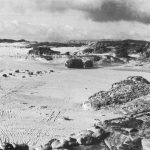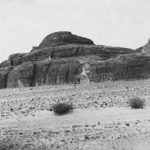WĀDĪ ḤAǦǦĀǦ
| Arabic | وادي حجّاج |
| English | Wadi Haggag |
| DEChriM ID | 73 |
| Trismegistos GeoID | 37483 |
| Pleiades ID | 746833 | PAThs ID | - |
| Ancient name | - |
| Modern name | Wādī Ḥaǧǧāǧ |
| Latitude | 28.8796 |
| Longitude | 34.4107 |
| Date from | - |
| Date to | - |
| Typology | Rock shelter |
| Dating criteria | - |
| Description | Wādī Ḥaǧǧāǧ, the Valley of the Pilgrims, is a 2km wide valley situated in central north-eastern Sinai, 40km north-east of the Monastery of St. Catherine. While it does not correspond to the traditional paths taken by pilgrims, it is nonetheless home to some 400 graffiti authored by travelers, with texts written in Nabatean, Greek, Latin, Hebrew-Aramaic, Coptic, and Armenian. The remains of buildings are present in the valley, though these have never received dedicated study (Palmer 1871: 312-313; Negev 1977: 3). It is rather the texts that have been the point of interest. Of the 210 Greek texts, it is estimated that at least 140 are undoubtedly Christian (Destephen 2014: 140). Of these, 4 are attributable to the fourth century (see: artefacts). It was suggested by Palmer that a “monkish colony” had at one point been present, but there is no evidence for this (Palmer 1871: 312-313). |
| Archaeological research | The first European to have visited the valley is said to have been J. L. Burckhardt in 1816, who identified ʿAyn Huderah, at the mouth of the Wadi, with the biblical Hazeroth (Burckhardt 1822: 495). The same ʿayn, and thus at least part of the valley, was then visited by E. Robinson in 1838 (Robinson 1841: 222-223). A brief description of ʿAyn Huderah was also included in the publication resulting from the ordnance survey of the peninsula, which included reference to the plethora of inscriptions (Wilson and Palmer 1869: 258-260). Later, the inscriptions were noted by A. P. Stanely (Stanley 1877: 62), though no mention was made of them by Flinders Petrie when he visited at the beginning of the 20th century (Flinders Petrie 1906: 62, figs. 185-186). The next recorded visit to the region by a European was that of the Portuguese monk B. Ubach in 1910 (Ubach 1955: 266). Serious epigraphic studies of the region did not commence until 1967 when several Israeli teams, such as the Israel Reservations Authority, began survey work. As a result of this, a handful of texts were given to A. Negev between 1967 and 1969 which he then published, after also having visited the site himself in 1970 (Negev 1971: 180-187). In preparation for the publication of additional texts, Negev decided to return to the site, and an expedition was subsequently organised by the Institute of Archaeology of the Hebrew University, with the aid of Mr. A. Goren, the then Archaeology Officer for Sinai. This was directed by Dr. O. Bar-Yosef who investigated early burial monuments, while A. Negev concentrated on Wādī Ḥaǧǧāǧ. During the expedition, a 7-8km long stretch of the valley was examined, with some 400 texts recorded, 270 of which have been published (Negev 1977). Ceramic from the valley was also analysed by Ms. Rosenthal which has subsequently aided in determining the chronology of site use (Negev 1977: 95-100). |
• Burckhardt, J. L. 1822. Travels in Syria and the Holy Land. London: The Association for Promoting the Discovery of the Interior Parts of Africa.
• Destephen, S. 2014. “L’épigraphie et la géographie du pèlerinage chrétien: L’exemple du Sinaï aux IVe-VIe siècles.” In Se déplacer dans l’Empire romain. Approaches épigraphiques, edited by S. Demougin and M. Navarro Caballero, 135-156. Ausonius: Pessac.
• Flinders Petrie, W. M. 1906. Researches in Sinai. New York: E. P. Dutton and Company.
• Horsley, G. H. R. 1982. “New Documents Illustrating Early Christianity 2: A Review of the Greek Inscriptions and Papyri Published in 1977.” p. 206-209. North Ryde: Ancient History Documentary Research Center, Macquarie University.
• Łajtar, A. 1992. “Isopsephy in a Greek Inscription from Wadi Haggag, Sinai.” Chronique d’égypte 67, 134: 332-334.
• Lifshitz, B. 1971. “Inscriptions de Sinaï et de Palestine.” Zeitschrift für Papyrologie und Epigraphik 7: 151-163.
• Negev. A. 1971. “New Graffiti from the Sinai.” Ezrets Israel 10: 180-187, pls. 59-65.
• Negev, A. 1977. The Inscriptions of Wadi Haggag, Sinai (Qedem). Jerusalem: Hebrew University of Jerusalem.
• Palmer, E. H. 1871. The Desert of the Exodus. Journeys on Foot in the Wilderness of the Forty Years' Wanderings. Undertaken in Connexion with the Ordinance Survey of Sinai, and the Palestine Exploration Fund, Part I, p. 256, 312-313. Cambridge: Deighton.
• Robinson, E. and E. Smith. 1841. Biblical Researches in Palestine, Mount Sinai and Arabia Petraea. A Journal of Travels in the Year 1838, vol. 1, p. 222-223. London: John Murray.
• Rothenberg, B. 1970. “An Archaeological Survey of South Sinai.” Palestine Exploration Quaterly 102: 4-29.
• Stanley, A. P. 1856. Sinai and Palestine in Connection with their History, p. 62, 80. London: John Murray.
• Ubach, B. 1955. El Sinaí: Viatge per l’Aràbia Pètria cercant les petjades d’Israel, p. 266. Monserrat: Abadia.
• Wilson, W. and H. C. Palmer. 1869. Ordnance Survey of the Peninsula of Sinai, Part II, p. 258-260. London: Southampton, Ordnance Survey Office.


 Json data
Json data





